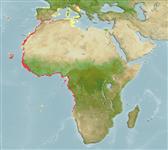Common names from other countries
Classification / Names / Names
Nomi Comuni | Sinonimi | Catalog of Fishes (gen., sp.) | ITIS | CoL | WoRMS
Environment: milieu / climate zone / depth range / distribution range
Ecologia
; distribuzione batimetrica 1 - 40 m (Ref. 4), usually 5 - 15 m (Ref. 4). Tropical; 14°C - 21°C (Ref. 112669), preferred 24°C (Ref. 107945); 45°N - 28°S, 26°W - 16°E (Ref. 4)
Eastern Atlantic and the Mediterranean: from Morocco to Namibia, and northwest Mediterranean.
Length at first maturity / Size / Peso / Age
Maturity: Lm 8.8, range 6 - ? cm Max length : 46.0 cm TL maschio/sesso non determinato; (Ref. 104052); common length : 25.0 cm TL maschio/sesso non determinato; (Ref. 441)
Minimum depth range from Ref. 122059. Inhabits shallow water from the sublittoral to 40 m, but is mostly found between 5 and 15 m with rocky bottoms (Ref. 4). Also found in sandy bottoms (Ref. 417). In general, palinurids are mainly considered carnivores, usually feeding upon sluggish, easily captured animals where most material is eaten alive or freshly killed (Ref. 105260).
Members of the order Decapoda are mostly gonochoric. Mating behavior: Precopulatory courtship ritual is common (through olfactory and tactile cues); usually indirect sperm transfer.
Holthuis, L.B. 1991. (Ref. 4)
IUCN Red List Status (Ref. 130435)
CITES status (Ref. 108899)
Not Evaluated
Not Evaluated
Human uses
Pesca: commerciale
| FIRMS (Stock assessments) | FishSource | Sea Around Us
Strumenti
Fonti Internet
Estimates based on models
Preferred temperature
(Ref.
115969): 18.6 - 27.9, mean 25.2 (based on 366 cells).
Vulnerability
Low vulnerability (25 of 100).
